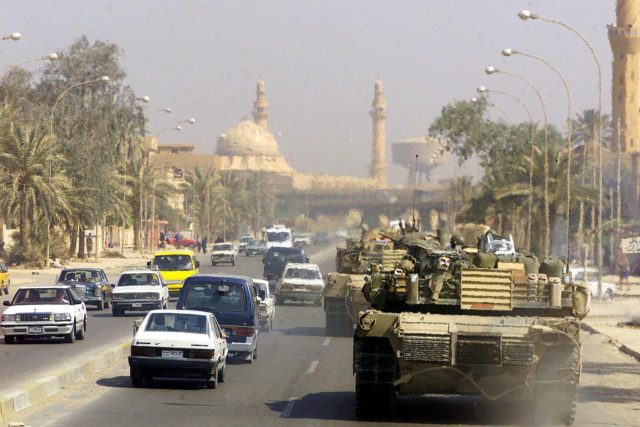
The US invaded Iraq 19 years ago today Two U.S. Marine Corps M1 Abrams tanks patrol the streets of Baghdad, Iraq on April 14th, 2003. (U.S. Marine Corps photo/Released)
On March 19, 2003 the U.S.-led coalition began the air war over Iraq. The following day — March 20, 2003 — U.S. forces began the ground war in Iraq.
The U.S. coalition launched “Operation Iraqi Freedom,” with the primary goal of overthrowing the Iraqi government under the regime of Saddam Hussein. The invasion followed calls from the U.S. and U.K. for the Hussein regime to surrender a suspected stockpile of weapons of mass destruction, according to a BBC timeline of the war in Iraq.
On Feb. 25, 2003 the U.S. and U.K. submitted a joint resolution to the U.N. stating Hussein’s regime had ignored calls to disarm. On March 17, then-President George W. Bush called on Saddam to leave Iraq and on March 18, U.K. Prime Minister Tony Blair won enough backing from the House of Commons to support the U.K. going to war in Iraq.
The initial “shock and awe” bombing effort on March 19 preceded the ground attack and formal invasion of Iraq on March 20.
The U.S. Marine Corps’ 15th Marine Expeditionary Unit had secured oil fields in southern Iraq, and the 1st Marine Expeditionary Force captured the Iraqi city of Nasiriyah and the Tallil Airfield.
U.S. Marines also captured key roads and bridges in the invasion.
By April 9, 2003, coalition forces had captured the Iraqi capital of Baghdad.
On May 1, Bush announced the end of the conventional war in Iraq and declared “mission accomplished” in defeating Saddam’s regime. The conflict in Iraq continued over the years that followed.
Hussein was captured by U.S. forces in the Iraqi city of Tikrit in Dec. of 2003. Around the time of his capture, the nature of the conflict in Iraq had changed into an insurgency, with suicide bombings and sectarian conflict.
Nineteen years later, U.S. forces are still engaged in Iraq, though the nature of the conflict has changed.
In 2006, Shia politician Nouri al-Maliki took power and formed a new government. In Dec. 2011, then-President Barrack Obama oversaw the last U.S. troops to leave Iraq.
In the years that followed the U.S. withdrawal, Iraq saw the rise of the Islamic State of Iraq and Syria (ISIS). U.S. forces returned to Iraq in 2014.
Under President Donald Trump, U.S. forces declared the territorial defeat of ISIS in March 2019. Efforts to leave Iraq have remained contentious, as U.S. military officials have warned of an ISIS resurgence and conflict with neighboring Iran has seen escalatory attacks and counter-attacks by pro-Iranian militias in Iraq and U.S. forces.




